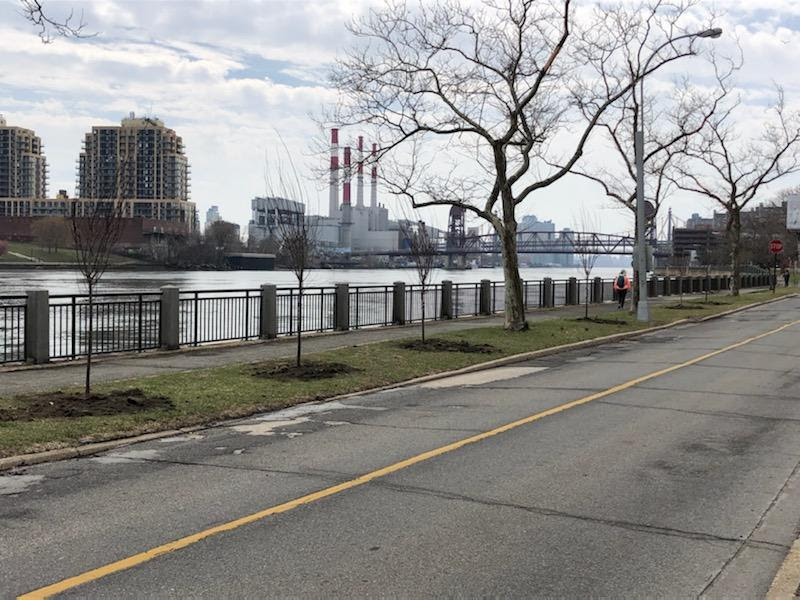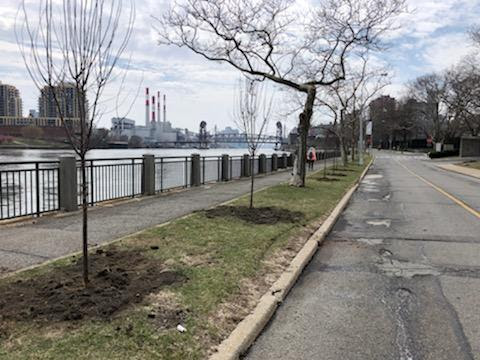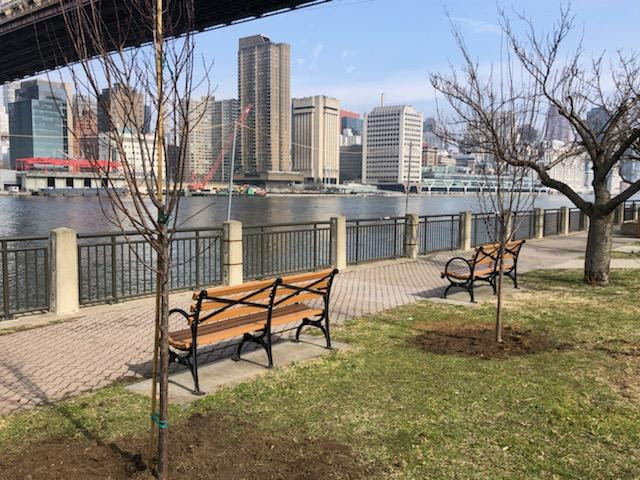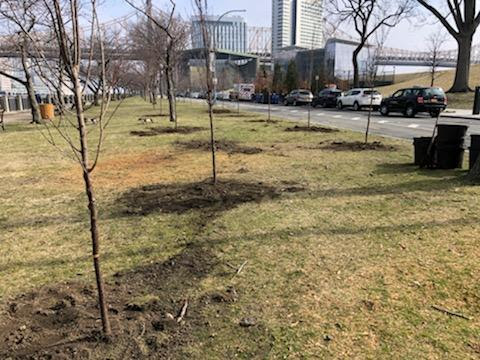Monday, March 21, 2022 – JUST A QUICK TRIP TO A FARM. GREAT FOR KIDS AND ADULTS

TWENTY NEW CHERRY TREES ARE PLANTED
Eight Kwasan cherry trees were planted along the East Road near the tennis courts and twelve trees were planted at the West promenade south end.
The trees were donated to the Roosevelt Island Historical Society by Material for the Arts. Thanks to Matt Kibby and Eddie Perez from RIOC, Plant Specialists for the planting. A special thanks to Tara Sansone at MFTA for arranging this anonymous donation. Last June MFTA donated 25 trees to the island. (Photo: Eddie Perez)

MONDAY, MARCH 21, 2022
628th Issue
THE QUEENS COUNTY
FARM
JUST MINUTES AWAY
The Queens County Farm Museum is a New York City Landmark, on the National Register of Historic Places and a member of the Historic House Trust of New York City.
Queens County Farm Museum dates back to 1697 and occupies New York City’s largest remaining tract of undisturbed farmland. The farm is one of the longest continuously farmed sites in New York State. The site includes historic farm buildings, a greenhouse complex, livestock, farm vehicles and implements, planting fields, an orchard, and an herb garden.
Queens Farm connects visitors to agriculture and the environment through the lens of its 47-acre historic site, providing learning opportunities and creating conversations about biodiversity, nutrition, health and wellness, climate change and preserving local history. It is a vital and rare resource in an ever-changing, continually developing city, and beyond.
The farm is owned by the New York City Department of Parks and is operated by the Colonial Farmhouse Restoration Society of Bellerose, Inc. Queens Farm’s programs are supported in part by public funds from the NYC Department of Cultural Affairs in partnership with the New York City Council. Additional support is provided by New York City Council Queens Delegation, Council Member Barry S. Grodenchik, Council Member Robert Holden, Council Member Peter Koo, and Council Member Francisco Moya. NYC Department of Youth and Community Development, and New York State Department of Agriculture and Markets.

History of Queens County, New York, with illustrations, portraits, and sketches of prominent families and individuals
Queens Farm’s 47-acre tract of farmland exemplifies the 300-year history of agriculture and farming as a way of life in New York City. The restored Adriance Farmhouse, the centerpiece of the farm complex, was first built as a three-room Dutch farmhouse in 1772. The farmhouse and surrounding 7-acre historic area mirror the evolution of this unique tract of land from a colonial homestead to a truck farm that served the needs of a growing city in the early twentieth century. The historic outbuildings, orchard, planting fields, vineyard, herb garden, and farmyard animals bring history to life.
In 1975, the founders of the museum obtained landmark designation for the structures and the surrounding land and worked diligently to open the site to the public. The important task of restoring the Adriance Farmhouse was completed in 1986. In addition, a master plan was prepared in 1986 to chart the course for future restoration and development of the site. An interpretive planning study, funded by the New York State Council on the Arts, was conducted in 1988. Both these initiatives were carried forward, using a team approach, with qualified outside professionals working closely with the farm’s staff and Board of Directors. To prepare for further expansion of the farm’s agricultural and educational programs, Quennell Rothchild & Partners were commissioned to develop a new master plan for the museum in 2009.
Queens County Farm Museum offers audiences a glimpse of how farm products travel from field to fork. Other important elements of the farm’s interpretation include the barns and outbuildings, livestock, orchard, apiary, herb garden and greenhouse complex.

Jacob and Catherine Adriance (1697 – 1808) The original landowner of what is now the Queens County Farm Museum was John Harrison. Harrison sold the farm to Elbert Adriance in 1697 beginning the Adriance family era which spanned over one hundred years and five generations. In 1704 Elbert died; his son Rem inherited the farm. Rem had two sons, Elbert and Jacob, upon Rem’s death in 1730 the farm was passed on to his older son, Elbert. In 1771 Elbert sold the portion of the land that is Queens County Farm Museum to his younger brother Jacob. Read More »
John Bennum, Sr. (1808 – 1822) John Bennum, Sr., purchased the farm from Albert Brinkerhoff in 1808 and farmed it until his death in 1822. His son ran the farm for a short time. The Bennums suffered various calamities; weather records indicate that severe droughts occurred on Long Island in 1819 and 1822. This was obviously devastating for farmers. Interestingly, weather may very well have altered the farm’s future as a defeated John Bennum, Jr., sold the farm’s mortgage to Daniel Lent in 1822.
Daniel Lent (1822 – 1833) Daniel Lent acquired the farm in 1822 and held it until 1833. During his ownership, the farm experienced two droughts and the floods of 1826. In June, 1826 Long Island recorded over 9 inches of rain in two days followed by record rainfalls in August of the same year. While Lent was trying to overcome these dramatic weather conditions, he had to contend with the rapid growth of new technology. Read More »
Peter Cox (1833 – 1892) Peter Cox purchased the farm at the very beginning of what would prove to be the most dynamic years of agricultural growth in our nation’s history. Cox had more than doubled the size of the modest three-room farmhouse by 1855. The farmhouse at the farm’s museum today includes both the original Adriance portion built in 1772 and the 1855 Cox expansion. Cox grew primarily wheat, corn, and, later, potatoes for local sale until his death in 1870. Read More »
Daniel Stattel (1892 – 1926) As it turns out, Daniel Stattel made a good investment when buying the farm; in 1900, only eight years after its purchase, the farm rated as the second largest in size in Queens County and the highest in dollar value. It was assessed at 32,000 dollars; 3,000 dollars more than the largest farm in Queens County. Stattel was a leader during the golden age of “truck farming,” or market gardening, sending record tonnage of crops to market by the wagon load. Read More »
Pauline Reisman (1926 – 1926) In 1926 the Stattels sold the farm to Pauline Reisman, a real-estate investor, and in less than six months she sold it to New York State for use by Creedmoor State Hospital. Though Ms. Reisman did not contribute any agricultural history of note, she was in fact the person who sold the farm to the state, probably sparing the site from the tidal wave of development that was taking place in Queens in the 1920s.
Creedmoor State Hospital (1926 – 1975) New York State purchased the farm in 1926 for Creedmoor State Hospital to use for rehabilitation of patients, growing fruits and vegetables for the kitchen at the hospital, and for growing ornamental plants and shrubs for the Creedmoor campus. With the exception of the farmhouse, Creedmoor demolished all the buildings on the farm, replacing them with buildings that met their needs. Read More » 1975 –
Present Today, Queens County Farm Museum is a New York City Landmark and on the National Register of Historic Places. Museum founder and president, James A. Trent, and New York State Senator Frank Padavan spared the farm from development in 1975. Senator Padavan wrote the legislation that transferred ownership from the state to the New York City Department of Parks & Recreation and protected the site from development for future generations. With all the present buildings restored, the master plan for the museum is being steadily pursued. The museum provides a broad spectrum of educational programs, public events, and services. The farm welcomes over 400,000 people each year. It is the second largest cultural institution in Queens based on visitor data.
MONDAY PHOTO OF THE DAY
Send your answer to:
rooseveltislandhistory@gmail.com

WEEKEND PHOTO OF THE DAY
NEW PEDESTRIAN BRIDGE AT 54TH STREET TO CLARA COFFEY PARK
Jay Jacobson and Hara Reiser got it.
from Laura Husse:
Pedestrian crossing over the FDR drive in the mid fifties connecting to the section of the Manhattan Greenway currently under construction on the East Side. Photo Taken from Roosevelt Island.

Sources
QUEENS COUNTY FARM
Edited by Deborah Dorff
ALL PHOTOS COPYRIGHT RIHS. 2022 (C)
PHOTOS IN THIS ISSUE (C) JUDITH BERDY RIHS


Copyright © 2022 Roosevelt Island Historical Society, All rights reserved.Our mailing address is:
rooseveltislandhistory@gmail.com





Leave a comment